Design and Test of Double-Cutterbar Structure on Wide Header for Main Crop Rice Harvesting
Abstract
:1. Introduction
2. Materials and Methods
2.1. Double-Cutterbar Configuration Methods
2.1.1. Upper Cutterbar Configuration Method Based on Rice Crop Deformation
2.1.2. Lower Cutterbar Configuration Method
2.1.3. Bending Experiment
- (1)
- Deform rice plant with a horizontal force on the point A to a designed deflection value ΔA;
- (2)
- Measure the actual curve of stalk and panicle lowest point;
- (3)
- Cut off the panicle and record the horizontal force Fre using a digital force meter;
- (4)
- Cut the stalk again at the height of 570 mm, which is a maximum value for yuc, and incline the stalk until the vertical height of stalk endpoint decreasing to hD;
- (5)
- Measured the actual curve of the stalk.
2.2. Shearing Tests within Whole Range of Rice Stalk
2.3. Prototype Development and Field Test
- (1)
- Stubble rolling rate:where, R is stubble rolling rate, %; Ari is stubble rolling area in each testing filed, ha; Aall is total area of the three fields, ha.
- (2)
- Panicle straw length: stop the harvester three times and collect 50 panicles from the header at each time. Measure and average the lengths of the stalk on panicle of all samples:where, La is panicle average straw length, mm; Li is panicle straw length on a single sample, mm.
- (3)
- Stubble height: randomly choose three spots in the test field after harvesting and select 50 stubbles at each spot. Measure and average the heights of all samples.where, Ha is stubble average height, mm; Hi is stubble height of a single sample, mm.
- (4)
- Feeding rate:where, Q is feeding rate, kg·s−1; Wv is total weight of grain harvested and discharges from cleaning parts in a time of t, kg.
- (5)
- Working efficiency:where, Ew is working efficiency, ha·h−1; T is total time consumed in harvesting of the three fields, h.
3. Results and Discussion
3.1. Verification Analysis of Double-Cutterbar Configuration Methods
3.2. Results of Shearing Tests and Analysis
3.3. Field Test of the Developed Harvester
4. Conclusions
- (1)
- The method developed based on rice plant deformation could offer considerable accuracy in upper configuration. The proposed method for a lower cutterbar could obtain a xlc, which is beneficial to cut stalks.
- (2)
- The shearing tests showed that shearing angle did not influence the shearing force (p < 0.05) of the whole range of rice stalk, while it significantly influenced the total shearing energy in Internode 2 and 3 (p < 0.05); the larger the shearing angle was, the more energy was consumed.
- (3)
- The stubble rolling rate, panicle length and stubble height of the tested harvester were 26.9%, 125 ± 80 mm and 332 ± 22 mm, respectively, indicating the functionality and practicability of the double-cutterbar structure developed.
Author Contributions
Funding
Acknowledgments
Conflicts of Interest
References
- Mohan, R.; Balasubramaniam, N.; Aruna, L.; Narayanan, A. Economic Viability of Ratooning Rice. Madras Agric. J. 2015, 299–302. [Google Scholar]
- Hafeez, S.; Jin, T.; Zhou, Y. Factors Affecting Yield and Yield Components of Main and Ratoon Rice: A Review. Agric. Sci. Technol. 2017, 18, 1228–1231. [Google Scholar]
- Shin, J.-H.; Kim, S.; Park, S. Effects of Stubble Height, Irrigation and Nitrogen Fertilization on Rice Ratooning in Korea. Korean J. Crop Sci. 2015, 60, 431–435. [Google Scholar] [CrossRef]
- Dou, F.; Tarpley, L.; Chen, K.; Wright, A.L.; Mohammed, A.R. Planting Date and Variety Effects on Rice Main and Ratoon Crop Production in South Texas. Commun. Soil Sci. Plant Anal. 2016, 47, 2414–2420. [Google Scholar] [CrossRef]
- Lin, W.-x. Developmental Status and Problems of Rice Ratooning. J. Integr. Agric. 2019, 18, 246–247. [Google Scholar] [CrossRef]
- Yuan, S.; Cassman, K.G.; Huang, J.; Peng, S.; Grassini, P. Can Ratoon Cropping Improve Resource Use Efficiencies and Profitability of Rice in Central China. Field Crop. Res. 2019, 234, 66–72. [Google Scholar] [CrossRef] [PubMed]
- Yadi, R.; Ebrahimi, M.; Dastan, S. Ratooning Parameters of Two Rice Cultivar in Modified Planting Systems. Int. J. Trop. Med. 2016, 11. [Google Scholar]
- Zhang, G.; Zhang, Y.; Huang, J.; Zhai, K.; Zhou, Y.; Huang, H.; Fan, Q. Designing and performance testing a novel head spike harvester of ratoon rice. J. Huazhong Agric. Univ. 2016, 35, 131–136. [Google Scholar]
- Lu, K.; Zhang, G.; Peng, S.; Lei, Z.; Fu, J.; Zha, X.; Zhou, Y. Design and performance of tracked harvester for ratoon rice with double-headers and double threshing cylinders. J. Huazhong Agric. Univ. 2017, 36, 108–114. [Google Scholar]
- İnce, A.; Uğurluay, S.; Güzel, E.; Özcan, M.T. Bending and Shearing Characteristics of Sunflower Stalk Residue. Biosyst. Eng. 2005, 92, 175–181. [Google Scholar] [CrossRef]
- Esehaghbeygi, A.; Hoseinzadeh, B.; Khazaei, M.; Masoumi, A. Bending and Shearing Properties of Wheat Stem of Alvand Variety. World Appl. Sci. J. 2009, 6, 1028–1032. [Google Scholar]
- Chattopadhyay, P.S.; Pandey, K.P. Mechanical Properties of Sorghum Stalk in Relation to Quasi-Static Deformation. J. Agric. Eng. Res. 1999, 73, 199–206. [Google Scholar] [CrossRef]
- Inoue, F.; Kim, Y.; Hashiguchi, K.; Okayasu, T.; Kashima, J. Mechanical Characteristics of Rice Stalk. J. Jpn. Soc. Agric. Mach. 1998, 60, 97–102. [Google Scholar]
- Hirai, Y.; Inoue, E.; Mori, K.; Hashiguchi, K. Analysis of Reaction Forces and Posture of a Bunch of Crop Stalks During Reel Operations of a Combine Harvester. Agric. Eng. Int. CIGR J. 2002. [Google Scholar]
- Huang, M.; Li, Y.; Chen, A.; Xu, L. Numerical Calculation Method of Deflection Deformation of Rice Stalk. Appl. Sci. 2019, 9, 3125. [Google Scholar] [CrossRef] [Green Version]
- Alizadeh, M.R.; Habibi, F. A Comparative Study on the Quality of the Main and Ratoon Rice Crops. J. Food Qual. 2016, 39, 669–674. [Google Scholar] [CrossRef]
- Allameh, A.; Alizadeh, M.R. Specific Cutting Energy Variations under Different Rice Stem Cultivars and Blade Parameters. Idesia 2016, 34, 11–17. [Google Scholar] [CrossRef]
- Tabatabaei, K.R.; Borgheei, A. Measuring the Static and Dynamic Cutting Force of Stems for Iranian Rice Varieties. J. Agric. Sci. Technol. 2006, 8, 193–198. [Google Scholar]
- Miu, P. Combine Harvesters: Theory, Modeling, and Design; CRC Press: Boca Raton, FL, USA, 2015. [Google Scholar]
- Hirai, Y.; Inoue, E.; Mori, K. Application of a quasi-static stalk bending analysis to the dynamic response of rice and wheat stalks gathered by a combine harvester reel. Biosyst. Eng. 2004, 88, 281–294. [Google Scholar] [CrossRef]

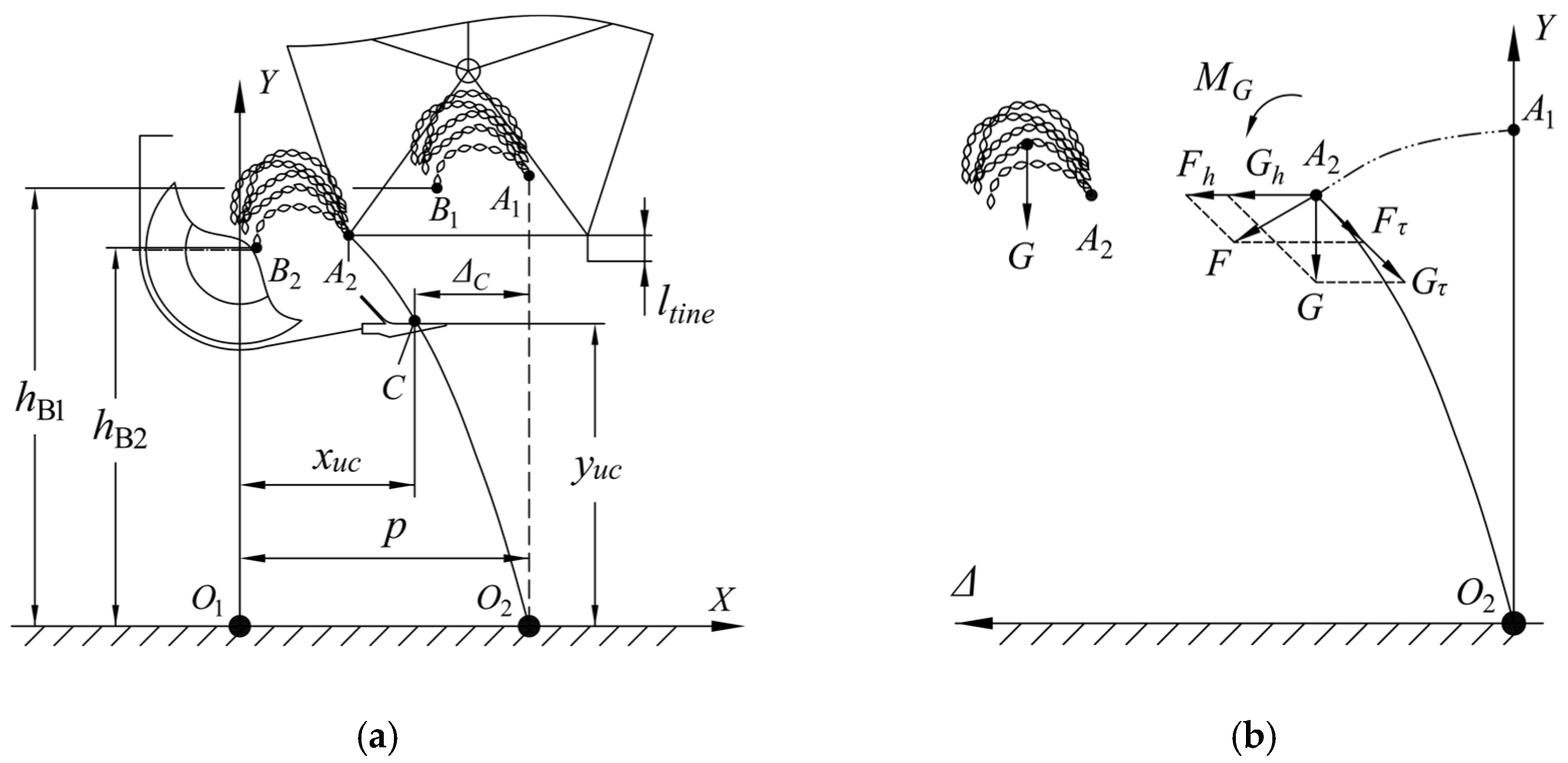
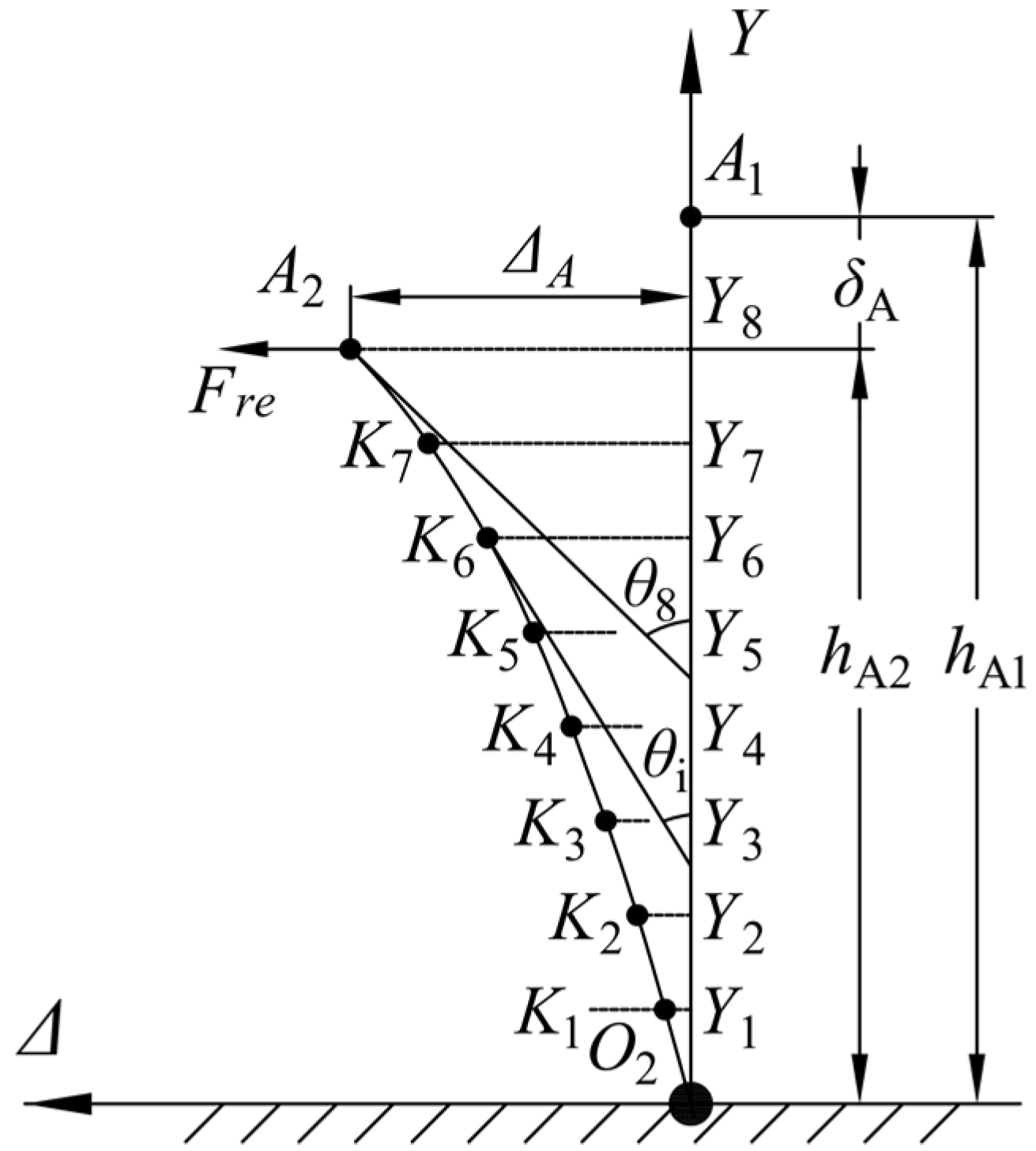
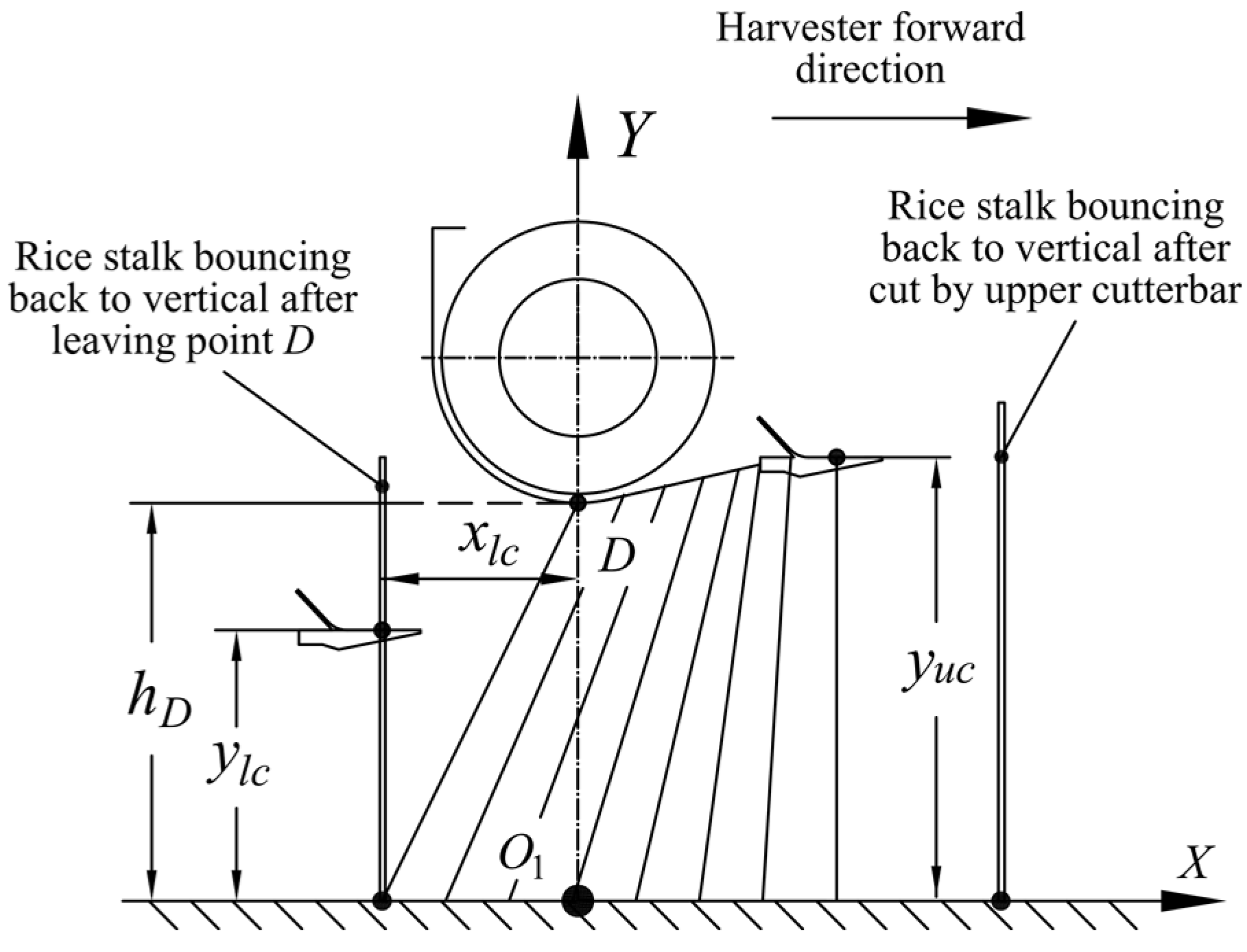
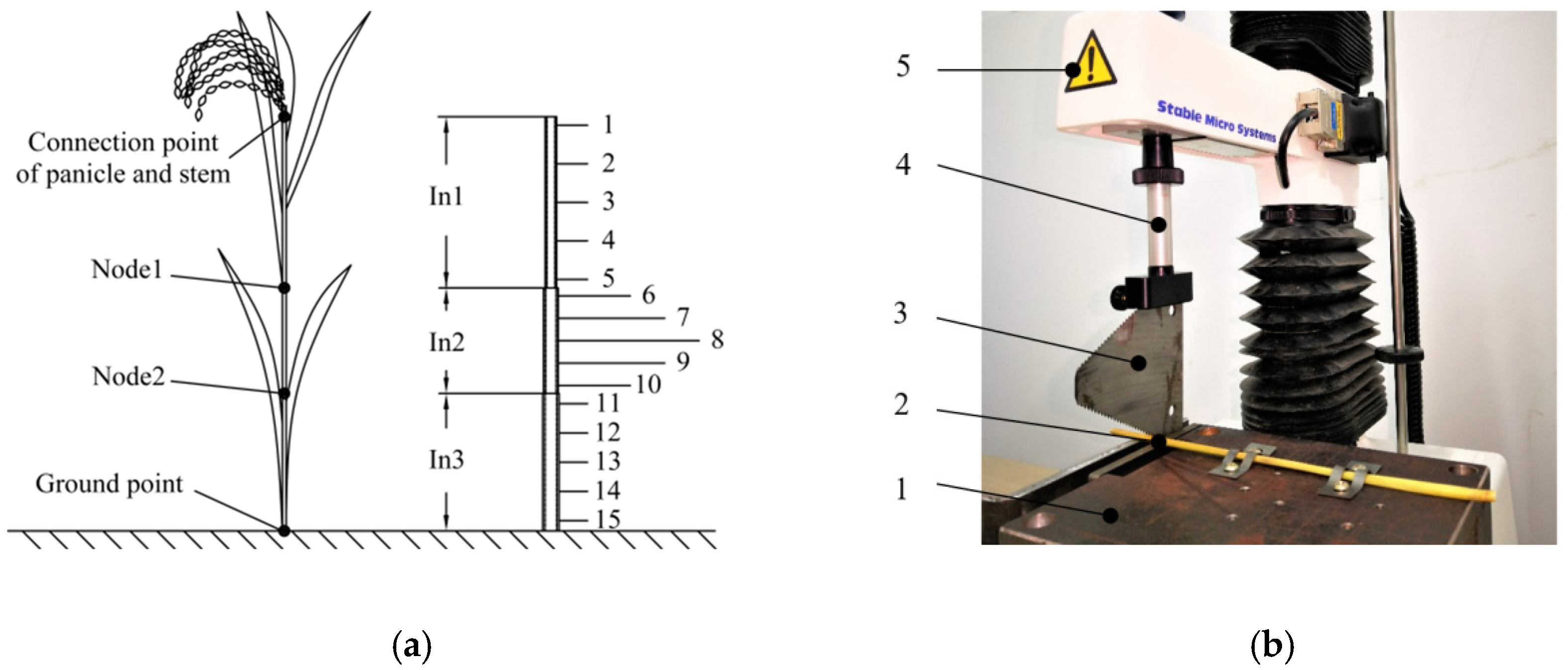
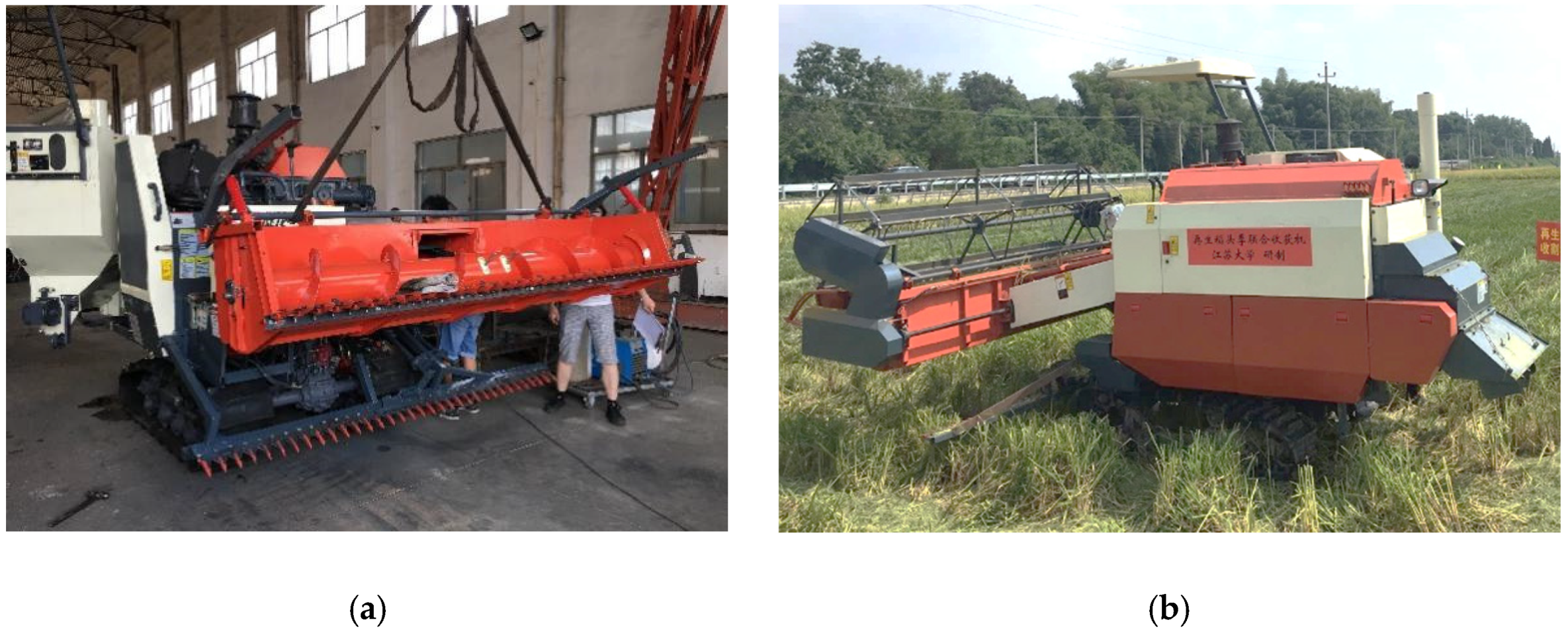

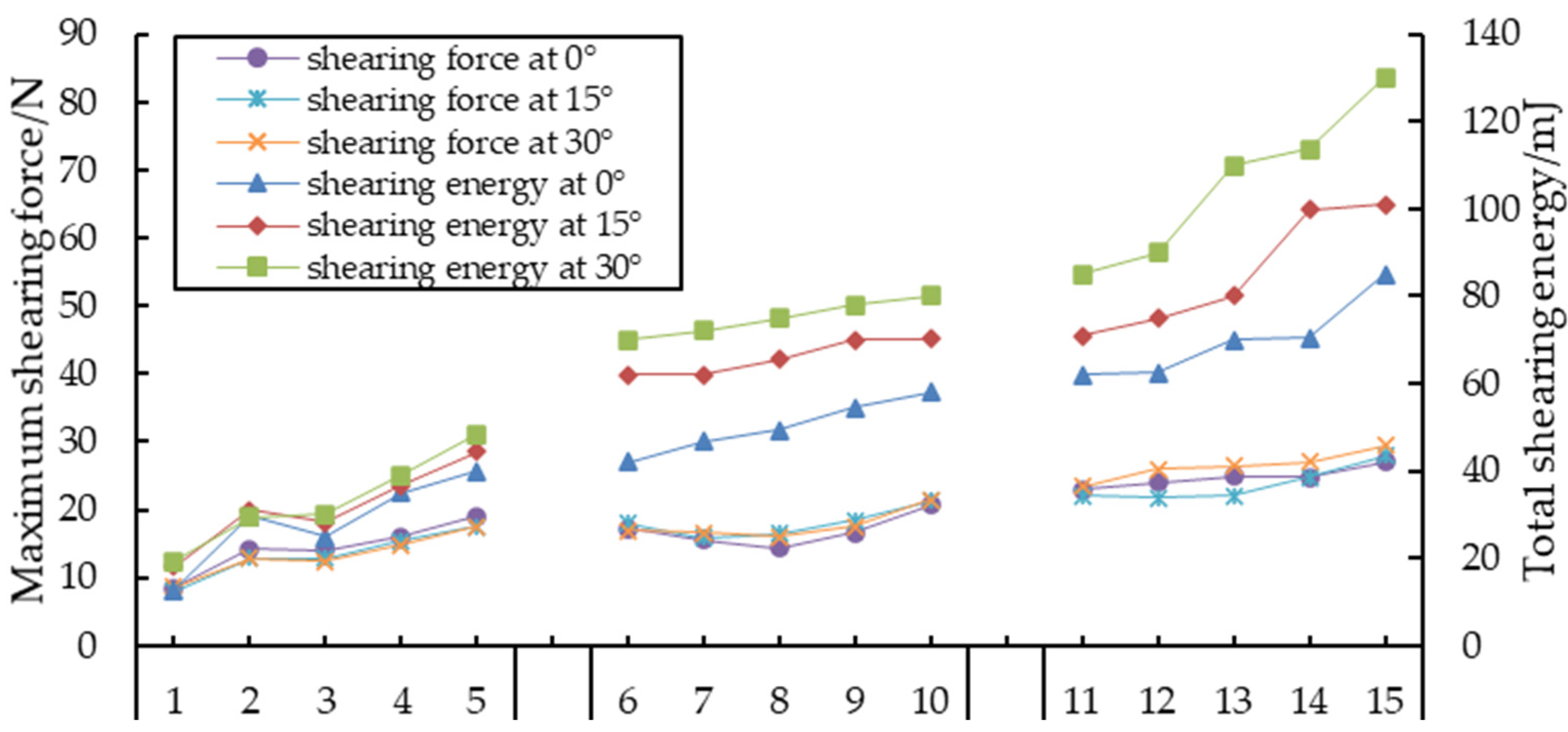
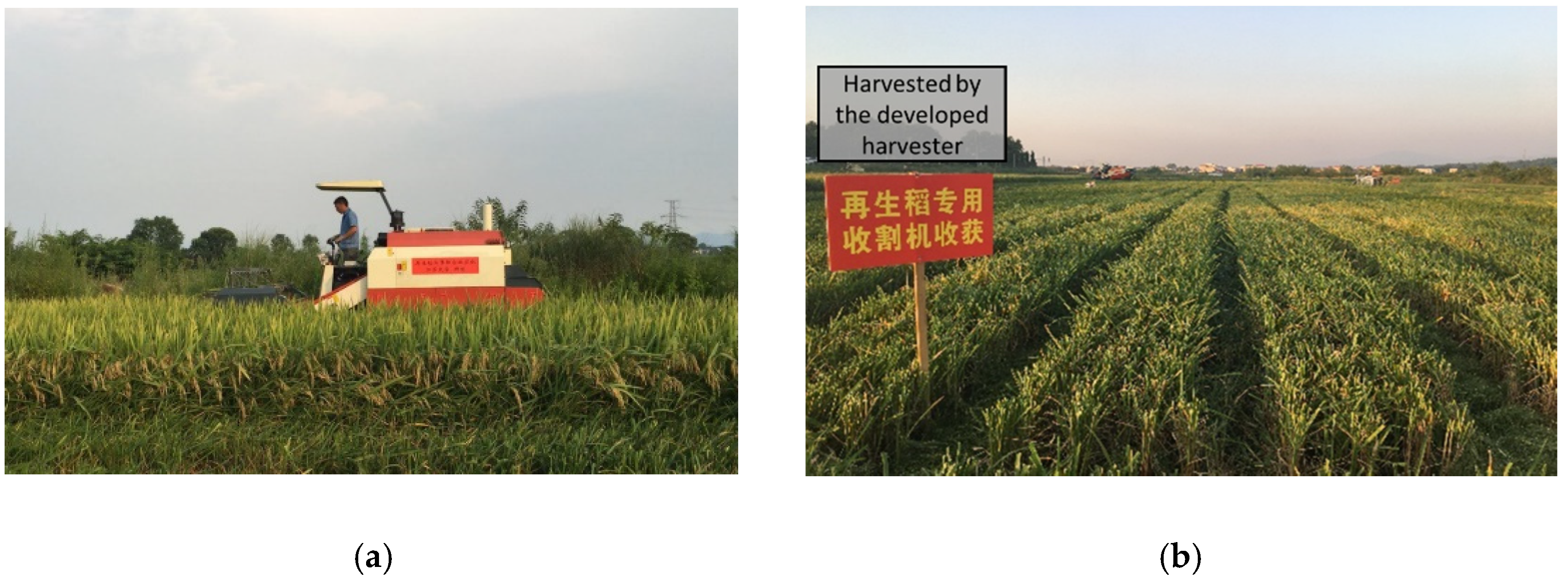
| Item | Value |
|---|---|
| Header width/mm | 2600 |
| Caterpillar width/mm | 350 |
| Machine power/kW | 51.5 |
| Reel speed/rpm | 45 |
| Auger speed/rpm | 200 |
| 1 | 2 | 3 | 4 | 5 | 6 | 7 | 8 | ||
| Maximum shearing force/N | 0° | 8.5 ± 5.9a | 14.2 ± 2.8a | 14.0 ± 3.0a | 16.0 ± 4.3a | 19.0 ± 3.5a | 17.3 ± 3.5a | 15.6 ± 3.1a | 14.3 ± 2.4a |
| 15° | 8.0 ± 2.1a | 12.8 ± 1.5a | 12.9 ± 2.1a | 15.4 ± 4.2a | 17.5 ± 2.6a | 18.0 ± 12.8a | 15.8 ± 1.1a | 16.5 ± 1.3a | |
| 30° | 8.6 ± 3.0a | 12.9 ± 2.9a | 12.5 ± 1.6a | 14.7 ± 3.2a | 17.6 ± 5.4a | 17.0 ± 3.0a | 16.7 ± 2.8a | 16.1 ± 3.6a | |
| 9 | 10 | 11 | 12 | 13 | 14 | 15 | |||
| 0° | 16.6 ± 2.7a | 20.7 ± 1.7a | 23.0 ± 3.1a | 24.0 ± 4.3a | 25.0 ± 11.0a | 24.8 ± 3.3a | 27.0 ± 6.8a | ||
| 15° | 18.4 ± 2.2a | 21.3 ± 4.5a | 22.0 ± 6.2a | 21.8 ± 3.0a | 22.0 ± 6.0a | 24.8 ± 10.7a | 28.0 ± 8.2a | ||
| 30° | 17.6 ± 3.3a | 21.4 ± 3.0a | 23.4 ± 2.4a | 26.0 ± 3.0a | 26.5 ± 12.2a | 27.0 ± 5.1a | 29.5 ± 6.2a | ||
| 1 | 2 | 3 | 4 | 5 | 6 | 7 | 8 | ||
| Total shearing energy/mJ | 0° | 12.6 ± 2.8a | 29.7 ± 8.3a | 25.0 ± 8.3a | 35.0 ± 19.1a | 40.0 ± 25.2a | 42.0 ± 22.6a | 46.9 ± 10.7a | 49.4 ± 10.3a |
| 15° | 18.3 ± 3.2a | 31.1 ± 7.6a | 28.1 ± 7.2a | 36.6 ± 13.2a | 44.5 ± 4.4a | 62.0 ± 54.7b | 62.0 ± 16.2b | 65.5 ± 15.8b | |
| 30° | 19.1 ± 2.4a | 29.3 ± 7.7a | 30.2 ± 6.8a | 39.1 ± 12.3a | 48.4 ± 19.4a | 70.0 ± 15.6b | 72.7 ± 16.8b | 74.9 ± 16.7c | |
| 9 | 10 | 11 | 12 | 13 | 14 | 15 | |||
| 0° | 54.5 ± 9.5a | 58.8 ± 3.7a | 62.2 ± 13.0a | 62.5 ± 19.6a | 70.0 ± 44.8a | 70.5 ± 55.4a | 85.0 ± 19.3a | ||
| 15° | 70.0 ± 27.9b | 70.3 ± 18.1b | 71.2 ± 42.4b | 75.0 ± 29.7b | 80.0 ± 8.2b | 99.8 ± 68.8b | 101.0 ± 45.2b | ||
| 30° | 78.0 ± 21.1c | 80.0 ± 8.4c | 85.0 ± 23.3c | 90.0 ± 19.2c | 109.9 ± 44.1c | 113.8 ± 45.7c | 130.0 ± 57.3c |
| Item | Developed Harvester |
|---|---|
| Stubble rolling rate/% | 26.9 |
| Panicle straw length/mm | 125 ± 80 |
| Stubble height/mm | 332 ± 22 |
| Feeding rate/kg·s−1 | 4.9 |
| Working efficiency/ha·h−1 | 0.53 |
© 2020 by the authors. Licensee MDPI, Basel, Switzerland. This article is an open access article distributed under the terms and conditions of the Creative Commons Attribution (CC BY) license (http://creativecommons.org/licenses/by/4.0/).
Share and Cite
Huang, M.; Li, Y.; Chen, A.; Xu, L. Design and Test of Double-Cutterbar Structure on Wide Header for Main Crop Rice Harvesting. Appl. Sci. 2020, 10, 4432. https://doi.org/10.3390/app10134432
Huang M, Li Y, Chen A, Xu L. Design and Test of Double-Cutterbar Structure on Wide Header for Main Crop Rice Harvesting. Applied Sciences. 2020; 10(13):4432. https://doi.org/10.3390/app10134432
Chicago/Turabian StyleHuang, Mingsen, Yaoming Li, Anya Chen, and Lizhang Xu. 2020. "Design and Test of Double-Cutterbar Structure on Wide Header for Main Crop Rice Harvesting" Applied Sciences 10, no. 13: 4432. https://doi.org/10.3390/app10134432





